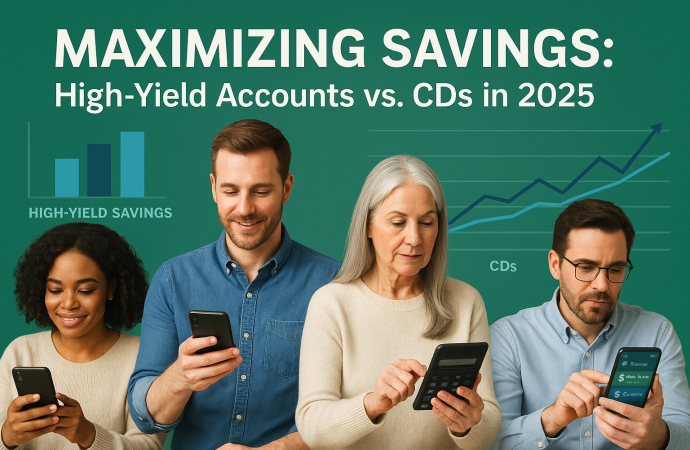Introduction In 2025, maximizing savings has become more important than ever, especially with rising living costs and inflation. As you look for ways to grow your money, it’s essential to understand the options available, particularly high-yield accounts and certificates of deposit (CDs). Both high-yield savings accounts and CDs can offer better returns than traditional savings
Introduction
In 2025, maximizing savings has become more important than ever, especially with rising living costs and inflation. As you look for ways to grow your money, it’s essential to understand the options available, particularly high-yield accounts and certificates of deposit (CDs).
Both high-yield savings accounts and CDs can offer better returns than traditional savings bank accounts, deposit accounts, joint accounts, but each has its own set of benefits and limitations. Knowing the differences can help you decide which option is best suited to your financial goals and financial institutions. In this article, we’ll compare high interest savings accounts, high-yield accounts, and CDs, examining their benefits, risks, higher rates, and suitability for different types of savers in 2025.
What Is a High-Yield Savings Account?

Image by: Yandex.com
A high-yield savings account is a type of savings account that offers higher interest rates compared to traditional savings account balances. These accounts are offered by online banks, credit card unions, and some traditional banks. In 2025, high-yield accounts continue to be a popular choice for people looking to earn more interest payments on their savings without locking in their money for an extended period.
High-yield savings accounts typically have no maintenance fees and are FDIC-insured (or equivalent, depending on the country), which means your money is protected up to a certain limit. They offer easy access to your funds, making them a flexible option for short- to medium-term savings goals.
Key Features of High-Yield Accounts:
- Higher interest rates: Offer significantly better interest rates than traditional savings accounts.
- Flexibility: Funds can usually be withdrawn or transferred easily.
- Safety: Deposits are insured by the government (FDIC or NCUA).
- No lock-in period: Unlike CDs, there is no fixed rate for your deposit.
What Is a Certificate of Deposit (CD)?

Image by: Yandex.com
A certificate of deposit (CD) is a time deposit offered by banks and credit unions that pays a fixed interest rate for a set period of time. The money you deposit into a CD is locked in for the term length you choose, ranging from a few months to several years. In exchange for this commitment, you usually get a higher interest rate than a high-yield savings account.
In 2025, CDs remain a good option for savers who can afford to keep their money tied up for a specific time frame. The longer the term, the higher the interest rate tends to be. However, if you withdraw your funds before the term ends, you may face early withdrawal penalties.
Key Features of CDs:
- Higher interest rates: Generally offer better rates than high-yield savings accounts.
- Fixed term: The money is locked in for a specified time period.
- No easy access to funds: Early withdrawals often result in penalties.
- FDIC-insured: Like high-yield savings accounts, CDs are insured by the government.
High-Yield Accounts vs. CDs: Comparing the Benefits

Image by: Yandex.com
1. Interest Rates
Both high-yield savings accounts and CDs offer higher interest rates than traditional savings accounts, but CDs often provide the higher returns. In 2025, the average high-yield savings account interest rate ranges from 1.5% to 2.5%, while CDs can offer rates between 2.5% and 4%, depending on the term length.
The main difference is that high-yield savings accounts allow you to withdraw funds whenever you need them, while CDs require you to keep your money locked in for a set period.
High-yield savings accounts may be better if you want liquidity and flexibility, while CDs are more suitable if you don’t need immediate access to your funds and want the highest possible interest rate.
2. Safety and Security
Both high-yield savings accounts and CDs are considered very safe, as they are typically insured by the government. In the U.S., high-yield savings accounts and CDs are insured by the Federal Deposit Insurance Corporation (FDIC) up to $250,000 per depositor, per bank.
This makes both options low-risk choices for savers looking for safe, government-backed deposits. However, since CDs often offer higher interest rates, they can be seen as a more attractive choice for those looking to maximize their savings without taking on more risk.
3. Minimum Deposit Requirements
High-yield savings accounts typically have low or no minimum deposit requirements, which makes them accessible to most people. Some online banks even offer high-yield savings accounts with no minimum balance.
On the other hand, CDs often have higher minimum deposit requirements, which can range from $500 to $5,000, depending on the bank and the specific product. However, if you are looking for a higher interest rate and can afford to lock in your money, CDs may still be a better option for you.
Future Outlook for 2025 and Beyond

Image by: Yandex.com
Looking forward, high-yield savings accounts and CDs will keep adapting to saver needs. We expect banks and fintech firms to roll out more flexible CD types, such as no-penalty CDs that let you withdraw without fees. Mobile apps will likely add features that compare rates across multiple banks in real time. Artificial intelligence could suggest the best mix of savings products based on your goals and spending habits. We may even see tools that automatically rebalance your laddered CDs when rates change. As digital banking grows, these products will become easier to use and more tailored to individual plans. Savers who follow new tools and remain flexible will find the most success in maximizing their returns.
Comparative Table: High-Yield Savings Accounts vs. CDs
| Feature | High-Yield Savings Accounts | Certificates of Deposit (CDs) |
|---|---|---|
| Interest Rates | 1.5% to 2.5% | 2.5% to 4% |
| Liquidity | High—withdraw anytime without penalty | Low—funds are locked for a term |
| Minimum Deposit | Low to no minimum deposit requirement | $500 to $5,000, depending on the bank |
| Penalty for Early Withdrawal | None | Yes—early withdrawal penalties |
| Ideal for | Short-term goals, emergency savings | Long-term savings, higher returns |
Conclusion
When deciding between high-yield accounts and CDs, it’s important to consider your savings goals, the amount of flexibility you need, and the return you want. High-yield savings accounts offer flexibility, liquidity, and easy access to your funds, making them ideal for short-term savings. On the other hand, CDs offer higher interest rates but require you to lock in your money for a specified term, making them a better option for long-term savings.
In 2025, both options remain excellent ways to maximize savings. Choose the one that best suits your financial goals and start saving smarter today!
















